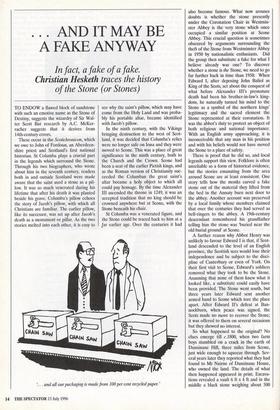. . AND IT MAY BE A FAKE ANYWAY
In fact, a fake of a fake. Christian Hesketh traces the history of the Stone (or Stones)
TO ENDOW a flawed block of sandstone with such an emotive name as the Stone of Destiny, suggests the wizardry of Sir Wal- ter Scott But research by A.C. McKer- racher suggests that it derives from 14th-century errors.
These occur in the Scotichronicon, which we owe to John of Fordoun, an Aberdeen- shire priest and Scotland's first national historian. St Columba plays a crucial part in the legends which surround the Stone. Through his two biographers, who wrote about him in the seventh century, readers both in and outside Scotland were made aware that the saint used a stone as a pil- low. It was so much venerated during his lifetime that after his death it was planted beside his grave. Columba's pillow echoes the story of Jacob's pillow, with which all Christians are familiar. The earlier pillow, like its successor, was set up after Jacob's death as a monument or pillar. As the two stories melted into each other, it is easy to
see why the saint's pillow, which may have come from the Holy Land and was proba- bly his portable altar, became identified with Jacob's pillow.
In the ninth century, with the Vikings bringing destruction to the west of Scot- land, it was decided that Columba's relics were no longer safe on Iona and they were moved to Scone. This was a place of great significance in the ninth century, both to the Church and the Crown. Scone had been a seat of the earlier Pictish kings, and as the Roman version of Christianity suc- ceeded the Columban the great saint's altar became a holy object to which all could pay homage. By the time Alexander III ascended the throne in 1249, it was an accepted tradition that no king should be crowned anywhere but at Scone, with the Stone beneath his chair.
St Columba was a venerated figure, and the Stone could be traced back to him at a pr earlier age. Over the centuries it had
. . and all our packaging is made from 100 per cent recycled paper '
also become famous. What now arouses doubts is whether the stone presently under the Coronation Chair in Westmin- ster Abbey is the very stone which once occupied a similar position at Scone Abbey. This crucial question is sometimes obscured by arguments surrounding the theft of the Stone from Westminster Abbey in 1950 by nationalistic enthusiasts. Did the group then substitute a fake for what 1 believe already was one? To discover whether a stone is the Stone, we need to go far further back in time than 1950. When Edward I, after deposing John Baliol as King of the Scots, set about the conquest of what before Alexander III's premature death had been his brother-in-law's king- dom, he naturally turned his mind to the Stone as a symbol of the northern kings' legitimacy and the sacred element the Stone represented at their coronation. It was the abbot's duty to protect an object of both religious and national importance. With an English army approaching, it is inconceivable that any man in his position and with his beliefs would not have moved the Stone to a place of safety.
There is proof that he did so, and local legends support this view. Folklore is often unreliable as a form of historical evidence, but the stories emanating from the area around Scone are at least consistent. One story tells how the monks carved a fake stone out of the material they lifted from the bed in the Annaty burn next door to the abbey. Another account was preserved by a local family whose members claimed that over the centuries they had served as bell-ringers to the abbey. A 19th-century descendant remembered his grandfather telling him the stone was 'buried near the old burial ground' at Scone.
A further reason why Abbot Henry was unlikely to favour Edward I is that, if Scot- land descended to the level of an English province, the Scottish sees would lose their independence and be subject to the disci- pline of Canterbury or even of York. On their first visit to Scone, Edward's soldiers removed what they took to be the Stone. Assuming that none of them knew what it looked like, a substitute could easily have been provided. The Stone went south, but three years later Edward sent another armed band to Scone which tore the place apart. After Edward II's defeat at Ban- nockburn, when peace was signed, the Scots made no move to recover the Stone; it was offered to them on several occasions but they showed no interest.
So what happened to the original? No clues emerge till c.1800, when two farm boys stumbled on a crack in the earth of Dunsinane Hill, three miles from Scone, just wide enough to squeeze through. Sev- eral years later they reported what they had found to Mr Naime of Dunsinane House, who owned the land. The details of what then happened appeared in print. Excava- tions revealed a vault 6 ft x 4 ft and in the middle a black stone weighing about 500 lbs made of meteoric rock. Next to it were two metal tablets with armorial insignia. One carried an inscription in Gaelic, which Mr McKerracher translated as 'Under your protective shadow lies the kingdom until angels carry you back to Bethel'.
Since 1818 nothing more has been heard of this stone. It was sent to London to be examined by a 'scientific amateur' whose name is unknown. What he did with it or whether at some point Mr Nairne took it back to Scotland no one seems to know. With so much current interest in the Stone of Destiny, would this not be an appropri- ate moment to pick up the trail?



































































 Previous page
Previous page